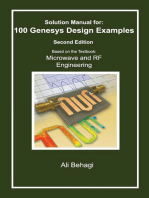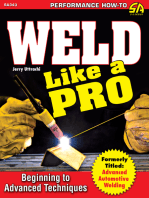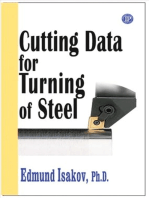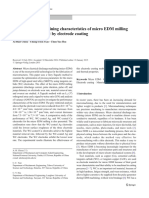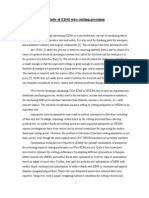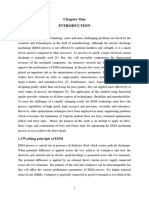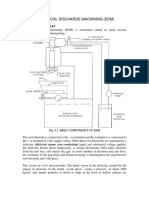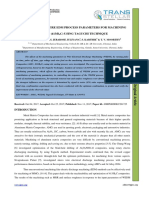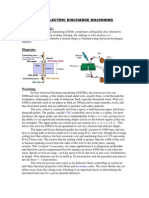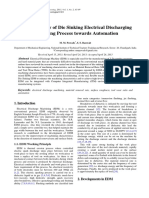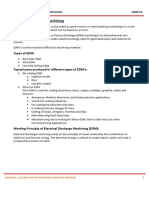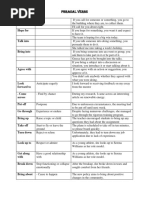CNC Wire-Cut Parameter Optimized Determination of The Stair Shape Workpiece
CNC Wire-Cut Parameter Optimized Determination of The Stair Shape Workpiece
Uploaded by
gargsumit107Copyright:
Available Formats
CNC Wire-Cut Parameter Optimized Determination of The Stair Shape Workpiece
CNC Wire-Cut Parameter Optimized Determination of The Stair Shape Workpiece
Uploaded by
gargsumit107Original Title
Copyright
Available Formats
Share this document
Did you find this document useful?
Is this content inappropriate?
Copyright:
Available Formats
CNC Wire-Cut Parameter Optimized Determination of The Stair Shape Workpiece
CNC Wire-Cut Parameter Optimized Determination of The Stair Shape Workpiece
Uploaded by
gargsumit107Copyright:
Available Formats
World Academy of Science, Engineering and Technology 70 2010
CNC Wire-Cut Parameter Optimized Determination of the Stair Shape Workpiece
Chana Raksiri, Pornchai Chatchaikulsiri
AbstractThe objective of this research is parameters optimized of the stair shape workpiece which is cut by CNC Wire-Cut EDM (WEDW). The experiment material is SKD-11 steel of stair-shaped with variable height workpiece 10, 20, 30 and 40 mm. with the same 10 mm. thickness are cut by Sodick's CNC Wire-Cut EDM model AD325L. The experiments are designed by 3k full factorial experimental design at 3 level 2 factors and 9 experiments with 2 replicate. The selected two factor are servo voltage (SV) and servo feed rate (SF) and the response is cutting thickness error. The experiment is divided in two experiments. The first experiment determines the significant effective factor at confidential interval 95%. The SV factor is the significant effective factor from first result. In order to result smallest cutting thickness error of workpieces is 17 micron with the SV value is 46 volt. Also show that the lower SV value, the smaller different thickness error of workpiece. Then the second experiment is done to reduce different cutting thickness error of workpiece as small as possible by lower SV. The second experiment result show the significant effective factor at confidential interval 95% is the SV factor and the smallest cutting thickness error of workpieces reduce to 11 micron with the experiment SV value is 36 volt. KeywordsCNC Wire-Cut, Variable Thickness Workpiece, Design of Experiments, Full Factorial Design
Conducttivity piece
Wire feed(from top to bottom) carrying electricity
Nozzle Discharge spark
Wire guide
Chip Workpiece Thickness
Wire guide Conductivity piece Wire tank Wire electrode
Fig. 1 Mechanism of Wire-cut EDM [1]
HE mechanism of Wire-cut Electric Discharge Machine ,WEDM, uses electricity to cut the metal with a brass wire conductors resulting in the discharge as shown in Fig.1 The work of WEDM is like cutting wood using a fret saw. WEDM are cutting as such, but uses electricity instead of saw cutting. WEDM will cut the material that has electrical conductivity. Harden steel and carbide are cut by WEDM. The advantages of WEDM over CNC conventional machine is the very hard material can be cut. The current cutting condition that controls WEDM to cutting different height as stair shape show in Fig. 2 cannot be controlled the accuracy of workpiece cutting thickness. The stair height is 10, 20, 30 and 40 mm in the same piece as show in Fig. 2 normally, the cutting parameter are designed to cut with constant workpiece height.
I. INTRODUCTION
In this case, the operators cannot select an optimal cutting condition to cut stair shape workpiece for more accuracy thickness. For the result example in Table I, three pass cutting workpiece stair shape with height 10, 20, 30 and 40 mm in the same piece was cut by selected cutting condition for 20 mm constant height.
Z+ X+ YCu gd ctio ttin ire n
Fig. 2 The cutting of variable thickness of workpiece with WEDM
Chana Raksiri, Department of Industrial Engineering, Faculty of Engineering, Kasetsart University, Bangkok 10900, Thailand, Tel: 662-942-8566-70; fax 662-942-8571; e-mail: fengcnr@ku.ac.th Pornchai Chatchaikulsiri, Engineering Management Program, Department of Industrial Engineering, Faculty of Engineering, Kasetsart University, Bangkok 10900, Thailand, e-mail: pornchai1981@yahoo.com
The accept thickness error of WEDM for 1, 2 and 3 pass cutting is 20, 15 and 10 microns, respectively. From the result in table I, the thickness errors were randomly and out of specification.
101
World Academy of Science, Engineering and Technology 70 2010
The objective of this research was parameters optimized by statistical design of experiments for the stair shape which was cut by CNC Wire-Cut EDM (WEDW). The experiment material was SKD-11 steel of stair-shaped with variable height workpiece 10, 20, 30 and 40 mm. with same 10 mm. thickness, were cut by Sodick's CNC Wire-Cut EDM model AD325L. The experiments were designed by 3k full factorial experimental design at 3 level 2 factors and 9 experiments with 2 replicate. The selected two factor were servo voltage (SV) and servo feed rate (SF).
Fig.3 Stair shape workpiece cutting by Wire-Cut Electrical Discharge Machine
TABLE I CUTTING SIZE ERROR IN THICKNESS 10, 20, 30 AND 40 MM Size of workpiece in each workpiece thickness (mm) 10 4.995 5.000 4.998 5.004 5.004 5.005 5.003 5.003 5.004 20 4.989 4.997 5.000 5.010 5.007 5.011 4.997 4.997 4.999 30 4.980 4.989 4.996 5.006 5.006 5.010 4.983 4.984 4.989 40 4.983 4.981 4.990 5.003 5.005 5.007 4.975 4.970 4.982 Average Cutting thickness error (Micrometer) 20
Cutting pass
Measure position Top Center Bottom Top Center Bottom Top Center Bottom
34
II. LITERATURE REVIEW Machine Wire Cut (Wire-Cut Electric Discharge Machine: WEDM) first used in 1960, which evolved from EDM in 1974. Dulebohn be applied to fiber optic control systems to automate the WEDM Later in 1975, its popularity is rapidly increasing as people know and understand many processes in industry. Later in the late 1970's solutions are set computer control (CNC) to use in WEDM are consequences. Has been used extensively to cut holes in the surpassed the wire that passes part to cut jobs at the WEDM in manufacturing will work press forming work dies RP Job aircraft parts, medical equipment and head Cut (Ho. et al., 2004)[2].
WEDM cutting process based on principles of electric heat that can be accurately cutting parts with complex shapes are difficult to cut. Part of edge cut is difficult to cut easily by WEDM technology WEDM based on taking advantage of the spark so that material come off where the spark is not the contact between the wire and WEDM is made the parts for the instruments used to head for a bite and make parts that are small and require high precision and good surface. Cutting machine that relied on discharge is not a traditional process. Electrical heating process. The erosion of material off the workpiece by spark between workpiece and wire by wire in a dielectric fluid. Electricity distribution will be made part melting and evaporation, and blown to wash out by the dielectric fluid, WEDM generate spark the wire (acting as electrodes) and part by water fine ions act as an intermediary for the electrical resistance and cutting the path defined by the program. The main goal of WEDM manufacturers and users will achieve stability and productivity by making better. Because new materials are being develop. Body parts are more complex. To overcome restrictions on use and WEDM in manufacturing growth increased continuously and rapidly. WEDM manufacturers and users to focus on success in the ability to manufacture with precision and surface interest. However, because of high variability, even workers with good skills can not be made to optimize. Effective way to solve this problem is to find the relationship between performance measurement process to fill the cutting condition used in the control (Mahapatra et al., 2003) [3]. WEDM process is a measure of variety and consistency of performance. Determine the best parameters with different performance properties is different. One possible way to solve such problems, problems with many variables to consider for the WEDM process, the first control and influence their level best corresponds to each variable and then it will resolve the conflict with relevant experience and knowledge engineering. However, the decision of men validity of results simply can not be assured. Beyond that different results can be found by different engineers. This means that the uncertainty in the control factor increases (Gauri et al., 2009) [4]. The problem when cutting with WEDM are wire break and instability cutting. These are major factors resulting in reduced performance for cutting WEDM. Especially when you look at cutting variable thickness workpiece. Traditional methods to determine the appropriate value for the cut is to select a value that is used for cutting the thickness of the smallest parts. This method will allow to reduce the possibility of the wire break and the lack of stability in cutting. However, the cutting speed is reduced dramatically (Liao et al., 2002) [5]. Ho et al. (2004) [2] found that the ON time wave, the frequency of discharge, the voltage open circuit, the servo voltage, capacity charge, speed tables and the intensity of current in the discharge ions affect the ability to cut jobs, such as surface roughness and cutting speed while the wire speed, wire tension and rate of flow of the medium with electrical resistance minimal impact. Tarng et al. (1995)[6] The servo reference voltage (SV):
102
World Academy of Science, Engineering and Technology 70 2010
The value of the servo reference voltage high, resulting in a time of waiting for the release of energy also high. However, the cutting speed will gradually slow down. Leads to the average of the difference of the release energy, so the conditions of large energy release is more stable but the number of cycles of energy is released within less time for energy Because of the stable cutting surface accuracy of better. Servo speed: the speed setting in motion when there is no load or the voltage higher than average the servo reference voltage (SV). General differences in the release of energy is less when the speed of movement of the work table is high and the result is a speed of cutting increased compliance with speed the movement of work table, but the accuracy of the surface is not good because the cutting speed increased. Liao, YS and YP Yu. (2004)[7] showed that ON time and the servo voltage is a significant factor in the discharge. Period of time will make more power efficient discharge reduction. Energy used in cutting depends ON time to supply a very long time more energy will be a lot of which imply the power of cutting the high percentage of the performance energy is paid to the pieces come off and the material is reduced significantly. The impact of the servo voltage discharge at this value even more will be made effective discharge decreased reason is because the values that will affect the phase will result in discharging the valuable lot is made. more distance parts of the energy is less than the discharge near the work piece. Kanlayasiri and Boonmung (2007)[8] the experimental design using the design strategy full factorial (2k) where k is the number of control variables in the experiment. The value in this experiment is power (ON), the time to stop paying power (OFF), the current maximum (Ip) and the tension wire (Wt) and the experimental use confidence interval at 95% and using ANOVA tests various hypotheses. Before that can be used ANOVA, will test the residual is normal distribution or not, are independent of each other or not and a constant variation does. Surface roughness describe by Fig.4 (Banleng and Prasert, 1981) [9] The average roughness Ra is equal to the height of the rectangle. The long-term lm rectangle is equal to the area as total area of the rough on the southern and central lines. The depth of roughness Rz that allows for the calculation of serial arithmetic mean of the depth of roughness (Z1 ... Z5) 5 values that are similar area. Maximum roughness depth Rmax is a maximum depth of the groove roughness during lm. From the literature review it is show the relationship between the performance of cutting parameters, experimental design, testing to find the cutting parameter that caused the
Roughness
Mean line
Fig. 4 Explain meaning of Ra, Rz and Rmax
cutting performance of the best. The cutting with the cutting parameters of WEDM machine different. Cutting performance will get the different result. Therefore, cutting parameter accuracy allows the performance of cutting up. One of the problems encountered when cutting with WEDM occurs when cutting variable thickness workpiece. The problem is during the cutting WEDM cutting areas in which change the thickness is wire break. In addition, the sizes of the specimen thickness in each are different. By finding the appropriate value to solve these problems. Require statistical methods to assist in the experiment. This research will lead to a full factorial experimental design used. Because the method is easy to understand and not complex. III. EXPERIMENTAL METHODS A. scope of this experiment 1) Cutting by hard brass wire diameter 0.2 mm 2) Workpiece was steel type SKD-11 3) Cutting with dielectric fluid resistivity 55,000 to 65,000 (Ohms.cm) 4) Thickness Cutting error less than 20 micrometer 5) Cutting with stair shape workpiece that have height 10, 20, 30 and 40 mm as show in Fig.5 6) Three pass cutting. 7) Responses of this experiment was difference cutting thickness error. 8) Not consider other factor such as temperature, dielectric flow rate. B. Experimental Sequence 1) Consideration factor for experiment The consideration factor of this experiment were servo voltage (SV) and servo feed rate (SF). The gap voltage and gap between workpiece and wire were controlled by servo voltage (SV) and the response of wire speed changed by gap voltage was controlled by servo feederate (SF). During cutting, gap voltage was controlled follow with servo voltage (SV) by speed adjustment and the response of speed change was controlled by servo feederate (SF). The response of this experiment is cutting thickness error of workpiece. 2) Design of experimental The full factorial 3k design at 3 level 2 factors, 9
103
World Academy of Science, Engineering and Technology 70 2010
experiments, 2 replicate was designed for this experiment as show in table II.
TABLE II FACTOR AND LEVEL IN 1ST SECTION EXPERIMENT Factor SV (Volt) SF (mm/min/volt) Level Middle 51 0.48
IV. RESULT AND DISCUSSION A. First experiment result The Minitab software was used to sort the first experimental by randomly. The first experiment results are shown in Table IV. The general full factorial design with confidential interval 95% ( = 0.05) analyze the experiment result by Minitab software with General Linear Model. The residual plots for cutting size error (Diff) show in Fig.8, that show the residual plots with a normal distribution, mean of error equals zero, constant variance and errors are independent. From the analysis in Fig.9 consider the confidential interval of 95 percent ( = 0.05) are the main factors affecting significantly the factor SV (which is determined by the Pvalue less than 0.05) and with no interaction effect significantly. This is determined by the P-value greater than 0.05 and graphs with no potential impact on the Fig.10.
TABLE IV FIRST EXPERIMENT RESULT Level SV (volt) 46 46 46 51 51 51 56 56 56 SF (mm/min/volt) 0.33 0.48 0.63 0.33 0.48 0.63 0.33 0.48 0.63 Cutting thickness error (micrometer) 2nd 1st replicate replicate 18 16 16 17 18 16 20 26 23 27 27 25 34 35 37 39 34 38
High 56 0.63
Low 46 0.33
3) Experiment The workpieces were cut into dimension as shown in Fig.5 The ten cutting thickness measuring points were measured as show in Fig. 6 by 0.001 mm resolution micrometer.
Order experiment 1 2 3 4 5 6 7 8 9
Fig. 5 Cutting workpiece dimension (unit: mm)
Residual Plots for Diff
Normal Probability Plot of the Residuals
99 90 Residual Percent 50 10 1 -4 -2 0 Residual 2 4 3.0 1.5 0.0 -1.5 -3.0 20 25 30 Fitted Value 35 40
Residuals Versus the Fitted Values
Histogram of the Residuals
6.0 Frequency Residual -3 -2 -1 0 1 Residual 2 3 4.5 3.0 1.5 0.0
Residuals Versus the Order of the Data
3.0 1.5 0.0 -1.5 -3.0 2 4 6 8 10 12 14 Observation Order 16 18
Fig. 6 Measurement position
TABLE III TABLE FOR RECORD SIZE DATA Measure position Top Center Bottom Cutting thickness Height of stair shape (mm) 10 20 30 40 Point 1 Point 4 Point 7 Point 10 Point 2 Point 5 Point 8 Point 11 Point 3 Point 6 Point 9 Point 12 error = (Maximum thickness size Minimum thickness size) for each height of stair shape
Fig. 8 Residual plot for cutting thickness error (Diff) in 1st experiment
104
World Academy of Science, Engineering and Technology 70 2010
Fig. 9 Analyze data by Minitab software from the result in 1st experiment
Interaction Plot (data means) for Diff
40
SV 46 51 56
will find that the cutting thickness error will be improved by reducing the factor SV. The Minitab software was used to sort the second experimental by randomly. The second experiment results are shown in Table V. With general full factorial design at confidential interval 95% ( = 0.05) then analyze the result by Minitab software with General Linear Model. The residual plot for cutting size error (Diff) show in graph at Fig.12, from the graph show that the residual plot have a normal distribution, mean of error equals zero, constant variance and errors are independent. From the analysis in Fig.13 consider the confidential interval of 95 percent ( = 0.05) are the main factors affecting significantly the factor SV (which is determined by the Pvalue less than 0.05) and with no interaction effect significantly. This is determined by the P-value greater than 0.05 and graphs with no potential impact on the Fig.14.
TABLE V SECOND EXPERIMENT RESULT Level SV (volt) 36 36 36 39 39 39 42 42 42 SF (mm/min/volt) 0.33 0.48 0.63 0.33 0.48 0.63 0.33 0.48 0.63 Cutting thickness error (micrometer) 2nd 1st replicate replicate 11 12 10 11 13 10 12 14 12 13 13 14 15 16 16 16 15 17
35
Mean
30
25
Order experiment 1 2 3 4 5 6 7 8 9
20
0.33
0.48 SF
0.63
Fig. 10 Interaction plot for cutting thickness error (Diff) in 1st experiment
Main Effects Plot (data means) for Diff
SV 35
99
SF
Residual Plots for Diff
Normal Probability Plot of the Residuals Residuals Versus the Fitted Values
1 Residual -2 -1 0 Residual 1 2 0 -1 10 12 14 Fitted Value 16
Mean of Diff
30
Percent
90 50 10 1
25
20
4.8 Frequency
Histogram of the Residuals
Residuals Versus the Order of the Data
1 Residual 0 -1
15 46 51 56 0.33 0.48 0.63
3.6 2.4 1.2 0.0 -1.5 -1.0 -0.5 0.0 0.5 Residual 1.0 1.5
Fig. 11 Main effect plot for cutting thickness error (Diff) in 1st experiment
6 8 10 12 14 Observation Order
16
18
From main effect plot in Fig.11, the smallest cutting thickness error, with SV equal 46 volt.
Fig. 12 Residual plot for cutting thickness error (Diff) in 2nd section experiment
B. Second experiment result From the result of first experiment, the trend of factors SV
105
World Academy of Science, Engineering and Technology 70 2010
Fig. 13 Analyze data by Minitab software from the result in 2nd section experiment
Interaction Plot (data means) for Diff
16 15 14 Mean 13 12 11
SV 36 39 42
Voltage (SV) parameter was less than 0.05 so the SV parameter was the main factor affecting significantly at confidential interval of 95 percent ( = 0.05). The cutting thickness error was improved as decreasing servo voltage from Fig. 11, the first experiment result show the smallest thickness error with servo voltage equal to 46 volt which will had an cutting thickness error in the cutting equal to 17 micrometer. The second experiment shows the improving cutting thickness error by reducing SV value. The main factors that affect significantly at confidential interval 95 percent of the responses to the factor SV which should select the level of factor SV equal 36 volts, which will had an cutting thickness error equal to 11 micrometer. From both experiment results show the cutting thickness error was improved and depend on servo voltage error so the smaller servo voltage value, the better cutting thickness error. The servo voltage cannot be set less than 36 volts because the gap between wire and workpiece is too small. REFERENCES
[1] [2] http://www.sodick.jp/tech/img/discharge_fig02_new.gif Ho, K. H., S. T. Newman, S. Rahimifard and R. D. Allen, State of the art in wire electrical discharge machining (WEDM), International Journal of Machine Tools and Manufacture., vol.44, 2004, pp. 12471259. Mahapatra, S. S. and A. Patnaik, Parametric Optimization of Wire Electrical Discharge Machining (WEDM) Process using Taguchi Method, Journal of the Brazilian Society of Mechanical Sciences and Engineering., vol.134, 2003, pp. 273-278. Gauri, S.K. and S. Chakraborty, Optimisation of multiple responses for WEDM processes using weighted principal components, The International Journal of Advance Manufacturing Technology., vol.40, 2009, pp. 1102-1110. Liao Y.S., M.T. Yan and C.C. Chang, A neural network approach for the on-line estimation of workpiece height in WEDM, Journal of Materials Processing Technology., vol.121, 2002, pp. 252-258. Tarng, Y.S., S.C. Ma and L.K. Chung, Determination of optimal cutting parameters in wire electrical discharge machining, International Journal of Machine Tools and Manufacture., vol.35, 1995, pp. 16931701. Liao, Y.S. and Y.P. Yu, Study of specific discharge energy in WEDM and its application, International Journal of Machine Tools & Manufacture., vol.44, 2004, pp. 1373-1380. Kanlayasiri, K. and S. Boonmung, An investigation on effects of wireEDM machining parameters on surface roughness of newly developed DC53 die steel, Journal of Materials Processing Technology., vol.187188, 2007, pp. 26-29. B. Soranin and P. Kuai-somboon, Metal properties. Bangkok: King Mongkuts Institute of Technology North Bangkok, 1981, pp. 91.
[3]
10 0.33 0.48 SF 0.63
Fig. 14 Interaction plot for cutting thickness error(Diff) in 2nd section experiment
Main Effects Plot (data means) for Diff
16 SV SF
[4]
[5] [6]
15 Mean of Diff
14
[7] [8]
13
12
[9]
11 36 39 42 0.33 0.48 0.63
Fig. 15 Main effect plot for cutting thickness error(Diff) in 2st section experiment
From main effect plot in Fig.15, the smallest cutting thickness error, with SV equal 36 volt.
V. CONCLUSION The first experiment result from Fig. 9, the p-value of Servo
106
You might also like
- Weld Like a Pro: Beginning to Advanced TechniquesFrom EverandWeld Like a Pro: Beginning to Advanced TechniquesRating: 4.5 out of 5 stars4.5/5 (6)
- IOSRJEN (WWW - Iosrjen.org) IOSR Journal of EngineeringDocument10 pagesIOSRJEN (WWW - Iosrjen.org) IOSR Journal of EngineeringIOSRJEN : hard copy, certificates, Call for Papers 2013, publishing of journalNo ratings yet
- 1optimization of Micro-WireDocument33 pages1optimization of Micro-WireAman BansalNo ratings yet
- Study of Sharp Corner Cutting in Wire EDM - Muhammad Iswan Ismail - TJ1191.M58 2008Document27 pagesStudy of Sharp Corner Cutting in Wire EDM - Muhammad Iswan Ismail - TJ1191.M58 2008asdfghjklNo ratings yet
- To Find Solution For Breakage of Wire During Wire Cut ProcessDocument31 pagesTo Find Solution For Breakage of Wire During Wire Cut ProcessManohar RajputNo ratings yet
- Edm Exp 6,7,9Document19 pagesEdm Exp 6,7,9Ali RazaNo ratings yet
- Effect of Current On EDMDocument58 pagesEffect of Current On EDMAli M. ElghawailNo ratings yet
- Study of Process Parameter of Wire Electric Discharge Machining The ReviewDocument5 pagesStudy of Process Parameter of Wire Electric Discharge Machining The ReviewIAEME PublicationNo ratings yet
- A Study of Electrical Discharge Grinding Using A Rotary Disk ElectrodeDocument9 pagesA Study of Electrical Discharge Grinding Using A Rotary Disk ElectrodeSarath ChandraNo ratings yet
- Electrode CoatingDocument8 pagesElectrode CoatingSaurabh JainNo ratings yet
- Exp 9Document8 pagesExp 9ManavNo ratings yet
- Optimal Control Parameters A Machining in CNC Wire EDM For TitaniumDocument20 pagesOptimal Control Parameters A Machining in CNC Wire EDM For TitaniumMarish KannanNo ratings yet
- Ultrasonic and Electric Discharge Machining To Deep and Small Hole On Titanium AlloyDocument6 pagesUltrasonic and Electric Discharge Machining To Deep and Small Hole On Titanium AlloysatishmaanNo ratings yet
- O. Blatnik, H. Orbanic, C. Masclet, H. Paris, M. Museau, J. Valentincic, B. Jurisevic and M. JunkarDocument5 pagesO. Blatnik, H. Orbanic, C. Masclet, H. Paris, M. Museau, J. Valentincic, B. Jurisevic and M. JunkarAmrik SinghNo ratings yet
- Optimization of Process Parameters in Die Sinking EDM - A REVIEWDocument6 pagesOptimization of Process Parameters in Die Sinking EDM - A REVIEWIJSTENo ratings yet
- 1114meij04 PDFDocument9 pages1114meij04 PDFAli RazaNo ratings yet
- MMP RohitDocument23 pagesMMP RohitRohit SinghNo ratings yet
- Metallurgical Alterations in The Surface of Steel Cavities Machined by EDMDocument8 pagesMetallurgical Alterations in The Surface of Steel Cavities Machined by EDMDeak Ferenc-JozsefNo ratings yet
- EDM Wire CutingDocument31 pagesEDM Wire Cutingmallpraxis100% (2)
- Experimental Investigation and Multi-Objective Optimization of Wire Electrical Discharge Machining (WEDM) of 5083 Aluminum AlloyDocument7 pagesExperimental Investigation and Multi-Objective Optimization of Wire Electrical Discharge Machining (WEDM) of 5083 Aluminum AlloyÐɤ Suman ChatterjeeNo ratings yet
- IJRPR21538Document8 pagesIJRPR21538Mohamadh2017 Alhahadh84No ratings yet
- Electrochemical Microfabrication Lab ME 374 - Manufacturing Processes LabDocument8 pagesElectrochemical Microfabrication Lab ME 374 - Manufacturing Processes LabJeevan GNo ratings yet
- Msword&Rendition 1Document22 pagesMsword&Rendition 1ashwini yewaleNo ratings yet
- Meena2017 Article Micro-EDMMultipleParameterOptiDocument8 pagesMeena2017 Article Micro-EDMMultipleParameterOptidertNo ratings yet
- MP 3 EdmDocument4 pagesMP 3 EdmSajjad SajjadNo ratings yet
- EdmDocument29 pagesEdmGaurav SinghNo ratings yet
- Review Article On Different Types of EDM and Its Performance Parameter Micro EDM2018 04-25-16!17!50Document6 pagesReview Article On Different Types of EDM and Its Performance Parameter Micro EDM2018 04-25-16!17!50swatiNo ratings yet
- Electrical Discharge Machining Thesis PDFDocument8 pagesElectrical Discharge Machining Thesis PDFfjfyj90y100% (2)
- Electrical Discharge Machining (Edm) : Process PrinciplesDocument11 pagesElectrical Discharge Machining (Edm) : Process PrinciplesPrasad ChikkamNo ratings yet
- ETJ - Volume 40 - Issue 1 - Pages 181-188Document8 pagesETJ - Volume 40 - Issue 1 - Pages 181-188Jabbar AljanabyNo ratings yet
- Fig. 1 Schematic Diagram of The Basic Principle of WEDM ProcessDocument6 pagesFig. 1 Schematic Diagram of The Basic Principle of WEDM ProcessHarinath GowdNo ratings yet
- Strojniški Vestnik - Journal of Mechanical Engineering Volume (Year) No, StartPage-EndPageDocument8 pagesStrojniški Vestnik - Journal of Mechanical Engineering Volume (Year) No, StartPage-EndPageSamad NadNo ratings yet
- Optimization of Wire Edm Process Parameters For Machining of Amcs (413/B C) Using Taguchi TechniqueDocument8 pagesOptimization of Wire Edm Process Parameters For Machining of Amcs (413/B C) Using Taguchi TechniqueTJPRC PublicationsNo ratings yet
- NTM 1 MokDocument10 pagesNTM 1 MokNick MaxNo ratings yet
- Wire EDMDocument2 pagesWire EDMDeepali MestryNo ratings yet
- Literature ReviewDocument34 pagesLiterature ReviewMuhammad WaleedNo ratings yet
- Wire EDM ProcessDocument10 pagesWire EDM Processgargi.gangwar.ecelliitkgpNo ratings yet
- EDM Wirecut 2 PDFDocument20 pagesEDM Wirecut 2 PDFDjuraTheHarpYNo ratings yet
- EDM WirecutDocument20 pagesEDM Wirecutnajieyuya100% (2)
- 1 s2.0 S1526612521000402 MainDocument8 pages1 s2.0 S1526612521000402 Mainjoskov71No ratings yet
- Effect of Process Parameters On Performance Measures of Wire EDM For AISI A2 Tool SteelDocument5 pagesEffect of Process Parameters On Performance Measures of Wire EDM For AISI A2 Tool SteelInternational Journal of computational Engineering research (IJCER)No ratings yet
- Investigating Effects of Process Variables On MRR in EDM by Using Taguchi Parameter Design ApproachDocument6 pagesInvestigating Effects of Process Variables On MRR in EDM by Using Taguchi Parameter Design ApproachPujara ManishNo ratings yet
- EdmDocument2 pagesEdmOmkar RahateNo ratings yet
- Drilling of CFRP by EDMDocument10 pagesDrilling of CFRP by EDMthasarathanr1993_939No ratings yet
- Optimization of Various Machining Parameters of Electrical Discharge Machining (EDM) Process On AISI D2 Tool Steel Using Hybrid Optimization MethodDocument9 pagesOptimization of Various Machining Parameters of Electrical Discharge Machining (EDM) Process On AISI D2 Tool Steel Using Hybrid Optimization MethodInternational Journal of Application or Innovation in Engineering & ManagementNo ratings yet
- Experimental and Numerical Study of Angu PDFDocument9 pagesExperimental and Numerical Study of Angu PDFGamini SureshNo ratings yet
- A Brief Review of Die Sinking Electrical Discharging Machining Process Towards AutomationDocument7 pagesA Brief Review of Die Sinking Electrical Discharging Machining Process Towards AutomationMayank Rajesh Kumar ShrivastavaNo ratings yet
- Lab Report EDMDocument5 pagesLab Report EDMMuzamil RazaNo ratings yet
- Edm WirecutDocument4 pagesEdm WirecutaaqibaminNo ratings yet
- 171 382 1 SM PDFDocument8 pages171 382 1 SM PDFsujayan2005No ratings yet
- EDM Notes2Document13 pagesEDM Notes2Revathi ChandruNo ratings yet
- Microstructure and Tensile Properties of Steel Wire Drawing: March 2013Document14 pagesMicrostructure and Tensile Properties of Steel Wire Drawing: March 2013mfg123No ratings yet
- Ultraprecision High Rate Anodic Dissolution Processes in EcmDocument7 pagesUltraprecision High Rate Anodic Dissolution Processes in EcmInternational Journal of Application or Innovation in Engineering & ManagementNo ratings yet
- Advnaced Wirecut ProcessDocument5 pagesAdvnaced Wirecut ProcessGomathi SankarNo ratings yet
- Spot Welding Interview Success: An Introduction to Spot WeldingFrom EverandSpot Welding Interview Success: An Introduction to Spot WeldingNo ratings yet
- Automated Optical Inspection: Advancements in Computer Vision TechnologyFrom EverandAutomated Optical Inspection: Advancements in Computer Vision TechnologyNo ratings yet
- The Concept of Social Banking Indian PerspectiveDocument9 pagesThe Concept of Social Banking Indian PerspectiveMadhavi BohraNo ratings yet
- 6480 49 35800 2 10 20230801Document12 pages6480 49 35800 2 10 20230801samsidar nidarNo ratings yet
- An Introduction To Survey Research - (Chapter 8 Presenting Survey Results)Document24 pagesAn Introduction To Survey Research - (Chapter 8 Presenting Survey Results)Adam HopeNo ratings yet
- 660MW Turbo Generator & Its AuxiliariesDocument88 pages660MW Turbo Generator & Its AuxiliariesAshvani Shukla100% (3)
- AIR BachDocument3 pagesAIR Bach呂志豪No ratings yet
- Client Peripherals Product Lines 1Document27 pagesClient Peripherals Product Lines 1prakistaoNo ratings yet
- Systèmes Électriques Résumés de Cours Et Problèmes Corrigés Sur: Machines À Courant Continu Réseaux Électriques Triphasés Transformateurs TriphasésDocument2 pagesSystèmes Électriques Résumés de Cours Et Problèmes Corrigés Sur: Machines À Courant Continu Réseaux Électriques Triphasés Transformateurs TriphasésbensumbbNo ratings yet
- Smart Money TrapDocument3 pagesSmart Money TrapKanickai Dsouza100% (2)
- Syllabus HYA Grade 12 2022-23Document3 pagesSyllabus HYA Grade 12 2022-23Anmol SinghamNo ratings yet
- D 2190 - 97 R01 - RdixotaDocument2 pagesD 2190 - 97 R01 - RdixotaRaphael CordovaNo ratings yet
- ArmaGelDT - TDS - EN-Dual TempDocument4 pagesArmaGelDT - TDS - EN-Dual TempLee Kok RoyNo ratings yet
- Chemical Kinetics Simulator: An Interactive Graphical ApproachDocument9 pagesChemical Kinetics Simulator: An Interactive Graphical Approachdr_m_azharNo ratings yet
- Sujan Das PT Test ReportDocument2 pagesSujan Das PT Test ReportMD Shadikul Huq ShezanNo ratings yet
- (Oxford Handbooks of Political Science) R. A. W. Rhodes, Sarah A. Binder, Bert A. Rockman-Handbook Political Institutions-Oxford University Press, USA (2006)Document456 pages(Oxford Handbooks of Political Science) R. A. W. Rhodes, Sarah A. Binder, Bert A. Rockman-Handbook Political Institutions-Oxford University Press, USA (2006)Perico de los Palotes100% (2)
- GMK Diagnostic ToolsDocument30 pagesGMK Diagnostic ToolsVarun SharmaNo ratings yet
- No 13 Formula To Setting Cointech2u To Make 1% To 7% Daily & CompaundingDocument4 pagesNo 13 Formula To Setting Cointech2u To Make 1% To 7% Daily & Compaundingsuccessteam75021No ratings yet
- Program Studi Pendidikan Bahasa InggrisDocument4 pagesProgram Studi Pendidikan Bahasa InggrisDevi Rafealia WijayantiNo ratings yet
- Week012-MultipleRow-LabExer008 Rivera DennisDocument3 pagesWeek012-MultipleRow-LabExer008 Rivera DennisMary Jane PagayNo ratings yet
- ZD30 Engine Fault ListDocument61 pagesZD30 Engine Fault Listlocario1100% (1)
- Resume Erica ChienDocument1 pageResume Erica Chienapi-302888664No ratings yet
- Cell Theory Historical Timeline ActivityDocument2 pagesCell Theory Historical Timeline Activityaura chavezNo ratings yet
- First Semester Design Examples - v15.1 PDFDocument167 pagesFirst Semester Design Examples - v15.1 PDFbexuxube100% (1)
- SICK OPEN TCP RA V1 0 enDocument17 pagesSICK OPEN TCP RA V1 0 enMauro SánchezNo ratings yet
- Phrasal VerbsDocument2 pagesPhrasal VerbsJunaid SaqibNo ratings yet
- IntentionDocument10 pagesIntentionWolf Runner100% (2)
- POL 317 (Puh 635)Document156 pagesPOL 317 (Puh 635)Rufus Michael-AinaNo ratings yet
- GL EN TwinPlus 182 132 10BBDocument2 pagesGL EN TwinPlus 182 132 10BBMoussa NdiayeNo ratings yet
- Honey House and Equipment LayoutsDocument32 pagesHoney House and Equipment LayoutsChris SevenNo ratings yet
- Om Manual C0162474Document154 pagesOm Manual C0162474Hydro Energy GroupNo ratings yet
- Main Report Fettling 03Document37 pagesMain Report Fettling 03Chintan PatelNo ratings yet
